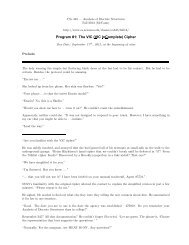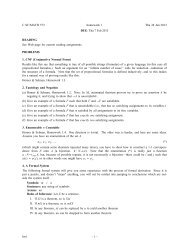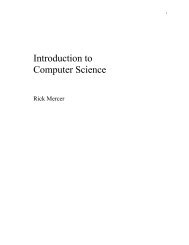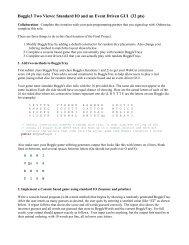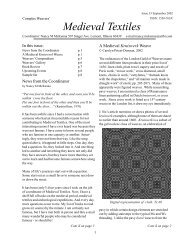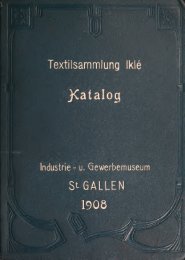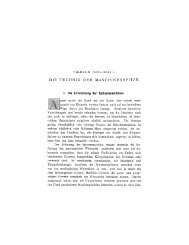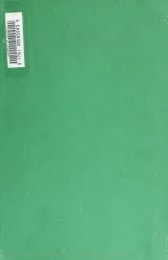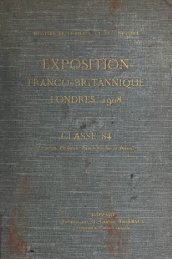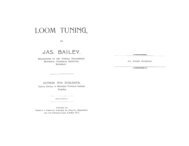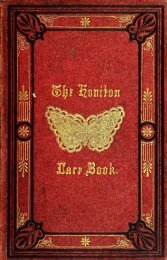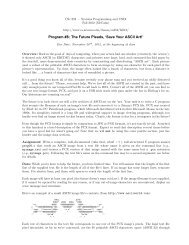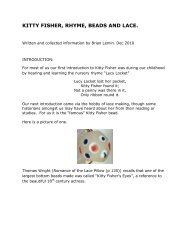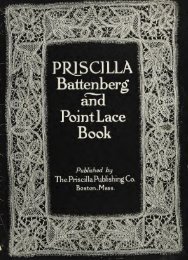Instructions for lace making ..
Instructions for lace making ..
Instructions for lace making ..
Create successful ePaper yourself
Turn your PDF publications into a flip-book with our unique Google optimized e-Paper software.
n^^rr^^C^.<br />
,f\r\f^t^<br />
hhff^ f\f\ft<br />
^\^\l^^Ar^l<br />
- '-^^^^fk^m'<br />
^Aa^A.^^^'"_ '^^<br />
j\^^p\f^<br />
AmK WAA^A»/?^.^^<br />
- ^ . ^ .^AAA^AA^^AA^ii
^Aai?<br />
^A'^Ann/TAAft^^/^Ar^.Ar\r^^AArr ,AAA/^v^r^^<br />
,r.Ahr^r^!<br />
>A^Arr ^fW^^^^O^^^'<br />
^'^^^h^^'B^mf^m^^^p-.^^^.,.
^ ^=
1<br />
..
Plate 1 Design in Point Lace <strong>for</strong> Tie. Page 42.
INSTRUCTIONS<br />
FOR<br />
LACE MAKING<br />
Numerous Illustrations.<br />
EDITED BY GEO. W. STATES.<br />
BOSTON<br />
PUBLISHHD BV J. H. KeATING, 282 WasHINGTiJN StREET.<br />
1878.
COPYRIGHT.<br />
J. H. KE^TING^.<br />
1878.<br />
'*.'v^
PREFACE<br />
The great and increasing interest felt throughout the<br />
country in the subject of Lace Making has led to the prep-<br />
aration of the present work. The Editor has drawn freely<br />
from all sources of in<strong>for</strong>mation, and has availed himself of<br />
the suggestions of the best <strong>lace</strong>-makers. The object of this<br />
little volume is to af<strong>for</strong>d plain, practical directions by means<br />
of which any lady may become possessed of beautiful spec-<br />
imens of Modern Lace Work by a very slight expenditure<br />
of time and f)atience. The moderate cost of materials and<br />
the beauty and value of the articles produced are destined<br />
to confer on <strong>lace</strong> <strong>making</strong> a lasting popularity.
BARS.<br />
CONTENTS.<br />
D'Alencon 26<br />
Point d'Angleterre 28<br />
Point de Venise, Edsjed 29<br />
Point de Ven ise, Dotted 29<br />
Raleigh 30<br />
Sorrento .25<br />
Sorrento, Dotted 25<br />
Venetian .Plain 27<br />
EDGINGS AND PURLED EDGINGS.<br />
Antwerp 34<br />
Brussels Edge 33<br />
Point d'Angleterre 34<br />
Point d'Espagne 35<br />
Point de Ven ise 33<br />
Sorrento 33<br />
PATTERNS.<br />
Borders 37<br />
Collars 44,47<br />
Tie End 41<br />
Edgings 40<br />
Handkerchief Border 39<br />
Tie 43<br />
Tie 46<br />
Medallion 36<br />
Oval <strong>for</strong> Cravats 35
star 35<br />
Toilet Cushion Centre 40<br />
POINT LACE.<br />
Braid, Placing the 12<br />
Braids 10<br />
Cords 9<br />
Edgings 32<br />
General directions <strong>for</strong>^Working 9, 11<br />
Materials Required 9<br />
Modes of Working Dots or Picots .28<br />
POINT LACE STITCHES.<br />
Brussels Lace 14<br />
Escalier Lace 22<br />
Mechlin Lace 22<br />
Poin t d'Angleterre 19<br />
Point d' Angleterre Enlarged 20<br />
Pointd'Anvers 46<br />
Point d' Alencon 18<br />
Point d'Alencon 18<br />
Point de Bruxelles 14<br />
Point d'Espagne 15<br />
Point d'Espagne, Close 16<br />
Point d'Espagne, Treble 16<br />
Point Grecque 46<br />
Point de Reprise 21<br />
Point Turque 20<br />
Point de Valenciennes 17<br />
Poin t de Venise 14<br />
Point de Venise, Petit 15<br />
WHEEL AND ROSETTES.<br />
English, Plain 24<br />
English, Raised 24<br />
Mechlin 24<br />
Rosettes <strong>for</strong> Centres 23<br />
Sorren to 23
POINT LACE<br />
The materials required <strong>for</strong> this elegant branch of needlework<br />
are neither numerous nor expensive. Tracing<br />
Cloth, Patterns on Colored Muslin, various Braids,<br />
Cords, Purl Edges, Linen Thread, and two or three<br />
sizes of needles, scissors and thimble. Tracing Cloth is<br />
required when ladies copy point <strong>lace</strong> patterns, and is the<br />
most convenient mode of taking them, as the design can be<br />
worked on the tracing cloth, which though transparent, is<br />
very strong. Colored Cambric is the material on which<br />
bought patterns are usually stamped.<br />
The braids are of various widths and kinds. The me-<br />
dallion, as No. 367, 384, etc. are Honiton, the plain, as No.<br />
503, 505, etc. are Point Lace Braids.<br />
Any of the stitches hereafter shown can be used in almost<br />
any piece of <strong>lace</strong> work, but the point de Bruxelles, the<br />
simplest, is most used, and is the foundation of all other<br />
stitches.<br />
Point Lace Cords are of various sizes, and are commonly<br />
called "butterfly cords." They are used <strong>for</strong> <strong>making</strong><br />
butterflies, and by some workers on very fine patterns, in<br />
stead of braid.
2. ^; umbers and Varieties of Braids.
Point Lace.<br />
We recommend" the Linen Lacet TiiREfAD which is<br />
put up in balls, and numbered from 200 to 1069. ^^ is very<br />
strong, has a beautiful, smooth finish, and has been used <strong>for</strong><br />
many years by the best <strong>lace</strong> makers. There is also a thread<br />
in skeins, which is perhaps equally good, but not so conve-<br />
nient.<br />
In working point <strong>lace</strong> the following directions must be<br />
attended to:—Begin at the left hand, and work from leit to<br />
right, when not otherwise directed, as in reverse rows. Be-<br />
<strong>for</strong>e cutting oftthe braid run a few stitches across it to prevent<br />
widening. Joins should be avoided, but when a join is indis-<br />
ptnsible, stitch the braid together, open and turn back the<br />
ends, and stitch each portion down separately. When pass<br />
ing the thread from one part to another, run along the cen-<br />
tre of the braid, allowing the stitches to show as little as<br />
possible. In commencing, make a few stitches, leaving the<br />
end of the thread on the wrong side and cutfing it off after-<br />
wards. In fastening off, make a tight button-hole stitch, run<br />
on three stitches, bring the needle out at the back and cut off.<br />
Having now completed oui list of materials, we can pro-<br />
ceed to lay on the braid.<br />
To P<strong>lace</strong>the Braid.—No 3 shows the design traced<br />
upon cambric or tracing cloth. Run on a straight line or<br />
braid <strong>for</strong> the lower edge, with fine stitches, working as<br />
shown from left to right. Take another piece of braid, 01<br />
the other end of the same piece, and begin to lay the braid<br />
by ''running" stitches in its centre, keeping it as smooth<br />
and even as possible. The outer edge presents no difficulty,<br />
but the inner edge will not lie evenly without being drawn<br />
: in by a needle and thread, as follows — Thread a No. gnee-<br />
1
3. Mode of Placing the Braid.
Point Lmt\ 13<br />
die with No. 500 thread about 20 inches long, fasten the<br />
thread to one point, and insert the needle in and out of the<br />
edge of the braid, as if <strong>for</strong> fine gathering; this thread when<br />
drawn up will keep the braid in its p<strong>lace</strong>. Two or three<br />
fastening off stitches should he worked when each circle,<br />
half circle, or rounded curve of a pattern is finished, as the<br />
drawing or gathering thread remains in the work, and <strong>for</strong>ms<br />
an important, though unseen part of its structure.<br />
As much of the beauty of point <strong>lace</strong> depends on the<br />
manner of placing the braid, ladies cannot bestow too much<br />
pains upon this part of the work, which is a little troublesome<br />
to beginners.<br />
The stitches used in point <strong>lace</strong> may be divided into :—<br />
Stitches Proper, qx points.<br />
Connecting Bars.<br />
Finishing Edgings.<br />
Wheels, Rosettes.<br />
The term point <strong>lace</strong>, or <strong>lace</strong> stitches (points), has of<br />
late been applied to every stitch executed with Mecklen-<br />
burg thread, and many stitches are erroneously named by<br />
modern writers. As there are more than one hundred<br />
stitches employed in this beautiful art, much study and op-<br />
portunity of seeing specimens of old point <strong>lace</strong> is required<br />
to give a novice any idea of the various kinds of point <strong>lace</strong> ;<br />
but by attention to the following stitches the rudiments of<br />
the art may be easily acquired and a very beautiful <strong>lace</strong><br />
produced.<br />
The first stitch is Point de Bruxelles, or Brussels<br />
<strong>lace</strong> stitch. This stitch, as may be clearly seen in illustra-<br />
iton No. 9, is a simple button-hole stitch worked loosely and
'4 Point Lace.<br />
with great regularity. The whole beauty of Brussels <strong>lace</strong><br />
depends upon the evenness of the stitches. This stitch is<br />
sometimes employed as an edging, but is more often worked<br />
4. Point de BruxeUes.<br />
in rows backwards and <strong>for</strong>wards, either as groundwork, or to<br />
fill spaces, as in the point <strong>lace</strong> collar, No. 54.<br />
5, Point de Bruxelles Worked in Rows,<br />
Brussels Point is the foundation of nearly all the <strong>lace</strong>t<br />
stitches.<br />
Point de Venise (Venetian or Venice Point) is worked<br />
from left to right, like Brussels point. Work one loose but-<br />
ton-hole, and in this stitch, work four button-hole stitches<br />
6. Point de Venise.
Foiiit Lnce, i 5<br />
tightly drawn up, then work another loose button-liole stitch,<br />
then four more tight button-hole stitches in the loose one,<br />
repeat to the end of the row, and fasten off.<br />
Petit Point de Venise ( Little. Venice Point) is<br />
worked in the same manner as Point de Venise, bin one<br />
Petit Point de Venise.<br />
tight stitch only is worked in each loose button-hole stitch.<br />
This is a most useful stitch <strong>for</strong> filling small spaces.<br />
No. 8. Point d'Espagne (Spanish Point) is worked<br />
8,<br />
Point d'Espagne.<br />
from left to right as follows :—Insert the needle in the edge<br />
of the braid, keeping the thread turned to the right, bring-
1 Point Lace.<br />
ing it out inside the loop <strong>for</strong>med by the thread, (see illustra-<br />
tion No. 8) ; the needle must pass from the back of the<br />
loop through it. Pass the needle under the stitch and bring<br />
it out in front, thus twice twisting the thread, which pro-<br />
duces the cord-like ai)pearance of this stitch. At the end<br />
of each row fasteti to the braid and return by sewing back,<br />
inserting the needle once in every open stitch.<br />
No. 9. Point d'Espagne (close) is worked im the<br />
same way as open point d'Espagne but so closely as to on-<br />
9. Close Point d'Espagne.<br />
ly allow the needle to pass through in the next row. This<br />
stitch is also worked from left to right ; fasten to the braid<br />
at the end of each row, and sew back to the left again.<br />
No. 10.— Point de Grecque is begun from left to<br />
right, is worked backwards and <strong>for</strong>wards, and is begun by-<br />
one stitch in loose point de Bruxelles, and three of close<br />
point d'Espagne ; then one Brussels, and three point d'Es-<br />
pagne to the end of the row ; in returning work back in the<br />
same manner.
Point Lace.<br />
10. Point de Grecque.<br />
No. 1 1. Point de Valenciennes (Valenciennes stitch.<br />
This stitch appears complicated, but is really easy to work.<br />
Begin at the left hand and work six point de Bruxelles<br />
stitches at unequal distance, every alternate stitch being<br />
larger, 2nd row : Upon the first large or long stitch, work<br />
9 close button-hole stitches, then i short point de Bruxelles<br />
11. Point de Valenciennes.<br />
stitch under the one above, then 9 close stitches, and so on<br />
to the end of the row, (right to left). 3rd row : 5 close button-<br />
hole in the 9 of previous row, I shortpointde Bruxelles 2 close
i8 Point Lace.<br />
in the Bruxelles stitch, i short point de Bruxelles, 5 close, i<br />
short point de Bruxelles, 2 close, i short, 5 close, i short, and<br />
repeat. 4th row: 5 close, i short point de Bruxelles, 2 close,<br />
I short, 5 close, i short, 2 close, i short, and repeat. Con-<br />
tinue the rows unti^ sufficient of the pattern is worked.<br />
ijY^Trm^-t^ \iKnA \\ w k\)\ wi\ T
Pomt Lace. 19<br />
The Point d'Alen^on No. 13 is a festoon of close<br />
button-hole stitch worked over the plain bars.<br />
14. Point d'Angleterre.<br />
No. 14. Point d'Angleterre, (Open English Lace).<br />
Open English <strong>lace</strong> is thus worked :—Cover the space to be<br />
filled in with lines of thread about one-eighth of an inch<br />
apart,^then <strong>for</strong>m cross lines intersecting those already made<br />
and passing alternately under and over them ; work a ro-<br />
sette on every spot where two lines cross, by working over<br />
and under the two lines about 16 times round, then twist<br />
the thread twice round the groundwork thread, and begin<br />
to <strong>for</strong>m another rosette at the crossing threads.<br />
No. 15. Point d'Angleterre enlarged to show ex-<br />
actly how to <strong>for</strong>m the rosette.<br />
No. 16. Point TuRQUE, (Turkish Stitch). This easy<br />
and effective stitch looks well <strong>for</strong> filling either large or<br />
small spaces ; the thread employed should be varied in<br />
thickness according to the size of the space to be filled.<br />
1st row :<br />
Work<br />
a loop, bringing the thread from right to left,<br />
passing the needle through the twist and through the loop.
20 Point Lace.<br />
15. Point d'Angleterre Enlarged.<br />
draw up tight and repeat. 2nd row: i straight thread from<br />
right to left. 3rd row : Work the same as first, using the<br />
straight thread in p<strong>lace</strong> of the braid, and passing the needle<br />
through the loop of previous row, as shown in illustration<br />
No. 16.<br />
it). Point Turque.
Point Lace. 21<br />
No. 17. Point de Reprise.— This stitch is worked<br />
by darning over and under two threads, <strong>for</strong>ming a triangle.<br />
The space is filled by parallel and cross bars, p<strong>lace</strong>d at equal<br />
distances, and on triangles thus produced, point de reprise<br />
is worked.<br />
17. Point de Reprise.<br />
No. 18. Mechlin Lace (MechHn Wheels).—This is<br />
one of the prettiest stitches in point <strong>lace</strong>, but also one of the<br />
most difficult to work correctly. It is thus worked : work<br />
a number of diagonal bars in button-hole stitch on a single<br />
thread in one direction, then begin the opposite side the<br />
same way, and work 5 or 6 stitches past the spot where the<br />
two lines cross, pass the thread round the cross twice under<br />
and over the thread to <strong>for</strong>m a circle. Work in a button-<br />
hole stitch half one quarter, make a dot by putting a fine<br />
pin in the loop instead of drawing the thread tight, and<br />
work 3 button-hole stitches in the loop held open by the<br />
pin, then take it out, and continue as be<strong>for</strong>e. Beginners
22 Pomt Lace,<br />
will do well to omit the dot, leaving the loop only on the<br />
18. Mechlin Lace Wheels.<br />
wheel. Mechlin wheels are also worked in rows upon hor-<br />
izontal and parallel lines of thread.<br />
No. 19.—EscALiER Lace.—This useful <strong>lace</strong> may be va-<br />
ried in pattern to any extent by placing the open stitches in<br />
any desired order; it then takes the name of diamond or<br />
Antwerp <strong>lace</strong>, according to the design. True escalier <strong>lace</strong><br />
is made by working 9 button-hole stitches close together ;<br />
then miss 3, that is, work none in the space that three stitch-<br />
19. Escalier Lace Worked In Diamonds.<br />
es would occupy—work 9, miss 3, as be<strong>for</strong>e to the end of the<br />
row; begin the 2nd. row 3 stitches from the end, to cause<br />
the open spaces to fall in diagonal lines—a succession of<br />
steps or stairs {escalier), which gives name to this stitch.
Point Lace. 23<br />
WHEELS AND ROSETTES.<br />
Wheels or rosettes are used to fill up circles, or in<br />
combination to <strong>for</strong>m <strong>lace</strong>. The simplest is<br />
The Sorrento Wheel.— Nos. 20 and 21.—This is<br />
worked by fastening the thread in the pattern to be filled up<br />
by means of the letters. Fasten it first at the p<strong>lace</strong> a, then<br />
at the p<strong>lace</strong> b, carrying it back to the middle of the first<br />
20 and '21. Sorrento Wheels.<br />
<strong>for</strong>med bar by winding it round, fasten the cotton at the<br />
p<strong>lace</strong> c^ carrying it back again to the centre by winding it<br />
round the bar, and so on ; then work over, and under the<br />
bars thus <strong>for</strong>med as in English <strong>lace</strong>. See page 23, and il-<br />
lustrations Nos. 20 and 21.<br />
No. 22. English Wheel.—This is worked in the<br />
same manner as the Sorrento wheel, but instead oi winding<br />
the thread over and under the bars, the needle is inserted un-<br />
der each bar and brought out again between the thread and<br />
the last stitch ; this gives a kind of button-hole stitch, and<br />
gives the square, firm appearance possessed by this wheel.
24<br />
Point Lace.<br />
22. English Wheel,<br />
No. 23. Rosette in Point d'Angleterre.—This ro-<br />
sette is worked in a somewhat similar manner to the wheel<br />
above described, the difference being that after each stitch<br />
;. Rosette in Raised Point d'Angleterre.<br />
passed round and under the bars, the thread is passed loose-<br />
ly round in the reverse direction, as shown in illustration<br />
No. 32, be<strong>for</strong>e proceeding to make the next stitch.
Point Lace. 25<br />
BARS.<br />
The word Ba^'s is applied to the various stitches used to<br />
connect the various parts of point <strong>lace</strong> work, and the beau-<br />
ty of the work depends greatly upon the class of bar and its<br />
suitability to the <strong>lace</strong> stitches used. The simplest bar is<br />
No. 24. The Sorrento Bar.—It is worked from right<br />
to left, a straight thread being carried across and fastened<br />
with a stitch. The return row consists of a simple twist un-<br />
24. Sorrento Bars.<br />
der and over the straight thread ; three of these bars are u-<br />
sually p<strong>lace</strong>d close together at equal distances between each<br />
group, the thread is sewn over the braid in passing from one<br />
25. Sorrento Bars.<br />
*
-:6 Point Lace.<br />
spot to another.<br />
No. 25.<br />
Sorrento bars are also applied as shown in illustration<br />
No. 26. D'Alen^on Bars are worked upon point de<br />
Bruxelks edging, and are only applied to the inner part of a<br />
patt^^, never being used as groundwork bars. The thread<br />
is mq^cly passed three times over and under the point de<br />
BruiJefl^^ stitches, the length of these bars being regulated<br />
26, D'Alencon Bars.<br />
by the space to be filled ; when the third bar is completed a<br />
tight point de Bruxelles stitch is used to fasten off the bar,<br />
the thread is passed through the next point de Bruxelles<br />
stitch, and a second bar begun.<br />
No. 27. The Venetian Bar is so simple that it hard-<br />
ly needs description. It is worked over two straight threads<br />
in reverse button-hole stitch.<br />
No. 28 — shows the Venetian bar applied as the "vein-<br />
ing"of a leaf, and worked upon Sorrento bars.<br />
No. 29.-—Venetian Bars are worked so as to <strong>for</strong>m<br />
squares, triangles, &c., in button-hole stitch upon a straight<br />
bread. The arrow in illustration points to the direction<br />
Tor working the next.
Point Lace.<br />
27. -J Venetian P.ai.<br />
30. Bars of Point d'Angleterre.—These bars tiiay<br />
be worked singly or to fill up a space, as in illustration.<br />
28. Venetian Bar,<br />
Work rosettes as in point d'Angleterre, page 19 ;<br />
when<br />
each rosette is finished twist the thread up the foundation<br />
thread to the top, fasten with one stitch, then ^ass it under<br />
the parallel line running through the centre and over into<br />
the opposite braid ; repeat on each side of each rosette, in
28 Point Lace.<br />
^^gggCOT.W.Vl.H>Ti;
J. U€,n,t, l^ULt. Z^J<br />
31. Point de Venise Bars Ed^ed.<br />
ent <strong>lace</strong> bars. Dotted point de Venise bars are worked as<br />
follows :<br />
32. Dotted Point de Venise Bars.<br />
Stretch the thread from right to left, on this work five<br />
:ight stitches of point de Bruxelles, then insert a pin in this<br />
last stitch to hold it open and loose, pass the needle under<br />
the loose stitch and over the thread, as clearly shown in il-<br />
lustration No. 32, and in this loop work 3 tight point de
30<br />
Point Lace.<br />
Bruxelles stitches. Then work 5 more stitches, and repeat<br />
to the end of the row.<br />
33. Picot, or Dot on Sorrento Bar.<br />
No. 33 shows a dot or picot upon a Sorrento bar worked<br />
between rows of pointMe Bruxelles, three twisted stitches<br />
being worked into the loop left by the twisted thread ; this<br />
<strong>for</strong>ms a picot resembling satin stitch in appearance.<br />
Nos. 34 and 35. Raleigh Bars are worked over a<br />
foundation or network of coarse thread, twisted in p<strong>lace</strong>s<br />
so as to more easily fall into the desired <strong>for</strong>m.<br />
3i. Raleigh Bars.
Point Lace. 31<br />
By following the numbering from No, i to 21, in No. 3s,<br />
a square p<strong>lace</strong> may be easily filled, and portions of this ar-<br />
rangement applied to <strong>for</strong>m groundwork of any shape desired.<br />
Upon this groundwork tight point de Bruxelles stitch-<br />
es are worked, and the dot worked upon these in one of the<br />
following ways :<br />
Dot or Picot.— ist Mode: Five tight point de Brux-<br />
elles stitches, one loose point de Bruxelles ;<br />
pass the needle<br />
under the loop and over the thread, as shown in point de<br />
Venise bars No. 45, draw up, leaving a small open loop as<br />
in tatting. Work five tight point de Bruxelles and repeat.<br />
2nd Mode : Proceed as above, but instead of continu-<br />
ing the tight stitches, work 2 or 3 tight stitches in the loop<br />
35, Network <strong>for</strong> Working Raleigh Bars
32<br />
Point Lace.<br />
thus <strong>for</strong>med, and repeat. 3rd Mode :<br />
Work<br />
4 tight point de<br />
Bruxelles stitches, i loose, through which pass the needle<br />
^pint, wind the thread 3 or 4 times round the point, as shown<br />
in illustration No. 36, press the thumb tightly on this, and<br />
draw the needle and thread throuo;h the twists. This is a<br />
quick mode of <strong>making</strong> the picot, and imitates most closely<br />
the real Spanish <strong>lace</strong>.<br />
Illustration No. 36 also shows how this stitch may be<br />
applied as a regular groundwork, but the beauty of old point<br />
groundwork bars is the variety of <strong>for</strong>m.<br />
ry^-i '?'?vit^^ 37! v-A7t7r^rtn^ ^ -^^ ^^t^<br />
31). Third mode of <strong>making</strong> Pieots or Dots,<br />
EDGES AND PURL FINISH.<br />
Most Modern Lace makers use a Purl Edge woven <strong>for</strong><br />
the purpose such as No. 128 on samples, but <strong>for</strong> those who<br />
wish to work the Edges the cuts and directions will be found<br />
useful, always bearing in mind that the stitches here shown<br />
are much enlarged <strong>for</strong> the sake of clearness in showing de-
Point Lace. 33<br />
tails.<br />
The simplest edge is point de Bruxelles which is worked<br />
somewhat like the stitch No. 9, and is secured by a knot<br />
worked in the braid. Many <strong>lace</strong> workers omit this knot.<br />
37. Point de Bruxelles Edging.<br />
No. 38. Sorrento Edging is worked with one short<br />
and one long stitch alternately.<br />
38. Sorrento Edging.<br />
No. 39. Point de Venise is worked precisely like that<br />
stitch (see page 14), three and even four stitches being<br />
worked in the loop.<br />
39. Point de Venise Edging.<br />
^
34<br />
Point Lace.<br />
No. 40. Point d'Angleterre Edging is worked in<br />
point de Bruxelles, the thread being again drawn through the<br />
braid be<strong>for</strong>e proceeding to the next stitch. This edging is<br />
strong and useful.<br />
40. Point d'Angleterre Edging.<br />
No. 41. Point d'Espagne Edging.—This stitch is ea-<br />
sily worked. Insert the point of the needle through the<br />
braid and wind the thread round it 20 times, draw the needle<br />
through these windings and draw the picot tight, sew over<br />
the braid the space of 3 stitches, and repeat.<br />
41. Point d'E«pi»gne Edging.<br />
No. 42. Antwerp Edge.—This edge is only a variety<br />
of point d'Angleterre edging, and differs only in the mode
of <strong>making</strong> the knot ;<br />
Point Lace. 35<br />
the thread is passed over, under, and<br />
through the loop <strong>for</strong>med by the point de Bruxelles <strong>lace</strong>.<br />
36 Point Lace.<br />
No. 44.<br />
Medallion in Point Lace.<br />
Materials: Braid No. 503. Lacet Thread No. 500, Purl No. J28.<br />
This medallion is useful <strong>for</strong> cravat ends and <strong>for</strong> a number<br />
of purposes, as trimming <strong>for</strong> sachets, dresses, &g. Hav-<br />
ing p<strong>lace</strong>d the braid'as be<strong>for</strong>e directed, work an English ro-<br />
41. Medallion in Point Lafe
Point Lace. 37<br />
sette in the centre, fill in the ground with point de fillet, or<br />
with point de Bruxelles, An edging of fine purl completes<br />
this pretty medallion.<br />
No. 45.<br />
Point Lace Border.<br />
Materials: Braui No. 155. Purl No. 129. Lace t Thread No. 600.<br />
This border represents the completed work shown on<br />
page 12. A point d'Angleterre rosette is worked in each<br />
circle. The plain braid is edged by Sorrento edging. Ven-<br />
ise bars are worked above the trimming, and treble point de<br />
Venise edges the border.<br />
45. Point Lace Border.<br />
No. 46. Point Lace Border.<br />
Materials: Braid No. 503. Thread No. 500.<br />
This border is both easily and quickly worked in Sor-<br />
46. Point Lace Border.
38 Point Lace.<br />
rento bars. The edge is worked in two rows of point de Briix-<br />
elles, or a purl edge as No. 128.<br />
No. 47. Honiton Lace LLandkercJiief.<br />
Materials : Honiton braid No. 367 or 314 Point braid No. 155. Purl No. 128.<br />
Lacet Tliread No. 500.<br />
The stitches employed in this pattern are English Ro-<br />
settes, d'Alencon bars, and point de Bruxelles, finished with<br />
a fine purl edge. This pattern can be used <strong>for</strong> other purposes<br />
and would make a very effective Scarf or Barb End.<br />
No. 48. Star-Centre <strong>for</strong> Toilette Cushion in Point Lace.<br />
Materials. Braid No. 503. Edge No. 128. Linen Lacet Thread No. 600.<br />
This beautiful star will be found useful <strong>for</strong> other pur-<br />
poses than as a toilette cushion cover, and is worked as fol-<br />
lows :<br />
English rosette in centre; Sorrento wheels in the 4 o-<br />
vals, worked with No. 500 thread ; point de Bruxelles (ground<br />
worked with No. 700 braid; edged with No. 128 purl. Th*^<br />
spaces may be filled with 2 or 4 contrasting stitches, taking<br />
care that they contrast well, and are p<strong>lace</strong>d alternately, aid<br />
worked in No. 500.<br />
49. Cravat End in Point Lace.<br />
Materials: Braid No. 564. Purl Edge No. 129. Nun's Lacet Thread No, 600.<br />
This cravat is worked in Sorrento wheels. Point<br />
d'Alenqon bars, and Sorrento edging.
47. Pattern <strong>for</strong> Handkerchief in Honiton.
40 Point Lace.<br />
48. Star-centre <strong>for</strong> Toilette Cushion in Point Lace.<br />
50 and ^ I. — Point Lace Edgings.<br />
Materials : Braid ]No. 503. Purl Edge No. j28. I.aeet Thread No. 70).<br />
These edgings can be used as a finish to insertions and<br />
50. Point Lace Edging,
B<br />
'L.mm<br />
^^m<br />
m<br />
mMm<br />
49. Cravat End in Point Laee.
I-'<br />
Point Lace.<br />
jihcr trimmings and <strong>for</strong> edging couvrettes. No. 50 is worked<br />
51. Point Lace Judging.<br />
Hiiii Sorrento wheels ; the edge in two rows of point de<br />
Bruxelles, a straight thread being drawn from the end to the<br />
beginning of each scallop over which the second row is work-<br />
ed. No. 5<br />
1 is worked with the same materials in treble point<br />
de Venise edged by the same, and finished off with a row of<br />
point de Bruxelles, the upper edge being worked in the same<br />
way.<br />
No. 52. Design in Point Lace <strong>for</strong> Neck Tie.<br />
See Frontispiece.<br />
Materials : Braid No. 503. Purl No. 129, Nuns Lacet No. 800 or 1000.<br />
This design may be used <strong>for</strong> a variety of purposes, and<br />
is extremely effective. The principal stitches required are<br />
given at the side of the pattern, a is Valenciennes <strong>lace</strong>, b<br />
Brussels net, - 53' Design in Honiton Lace<strong>for</strong> Neck Tie.<br />
The principal stitches are the point d'Alen^on No. i8,<br />
find English wheel No. 34. The braids to be used are No,<br />
•50 ^ and No. 367 with the finest purl edge.
Point Lace.<br />
Design in Honiton Lace <strong>for</strong> Neck Tie.<br />
No. 5 4.— Point Lace Collar,<br />
Materials ; Braid No. 15i. Edge No. YD. Laeel Tluead No. 1000<br />
The Grecian line is worked in point de reprise, the pat-<br />
tern in close English wheels, point de reprise, point de Brux-<br />
elles, English rosettes, and Ralciirh bars.
5^. Point Lace Collar,
55. Point Lace Tie
46 Point Lace.<br />
No. 55. Point Lace Tie.<br />
Materials: Braid No 546. Purl 12S. Lacet Thread No. 70(1,<br />
This Tie is exceedingly pretty. It is composed of<br />
the following stitches :— -Point d'Alengon, point de tulle<br />
English rosettes, Sorrento bars, d'Alen^on bars, dotted Ve-<br />
5(» Point (PAnvrrs. 57. Point Greeque.<br />
nise bars, and the fancy stitch point d'Anvers, which is not<br />
a true point <strong>lace</strong> stitch, but which is much employed in<br />
modern point.<br />
Point Greeque is another useful variety of fancy stitch,<br />
and so easily worked as to be a favorite stitch with begin-<br />
ners.<br />
No. 58.—Design in Ho niton Lace <strong>for</strong> Ladies Collars<br />
and Ciijfs.<br />
Materials:—Honiton Braid No. :?14, 38t, or 263. Point Laoe Braid No. zm.<br />
Purl Edge N. 128. Lacet Thread No. 500 or 800.<br />
The work in this pattern is very simple, and any be-
f^%c^S>'^^<br />
Point Lace. 4;<br />
58. Design in Honiton Lace <strong>for</strong> Ladies' Collars and Culls,<br />
ginner can succeed in doing it. The stitches are the Sor-<br />
rento Wheel, No. 33, Point d'Alen^on, No. 18, English-<br />
Wheel, No. 34, finished with a fine purl edge.
4><br />
f<br />
S T _iL T E S'<br />
No. 11 TEMPLE PLACE,<br />
Nsar Tremont Street, BOSTON.<br />
»* ^^ . ^.^<br />
Ii^CE-fP^Kipig'.»a*<br />
Honiton and Point Lace Braids^ Purlings^ ^^ Au Petit<br />
Moulins'' Linen^ Lace Threads^ Etc.<br />
For laMiig Lace Collars, Cuffs, Barlis, &c.<br />
Stampi:iT0 far all ktittrs nf ^mbroitrerg,<br />
Also, Initials and Monograms Designed <strong>for</strong> Table Linen &c.<br />
Embroidery to order in the Very Finest Work at Short Notice.<br />
Designs and Samples of Work can be seen -at Store.<br />
PATTERNS AND PRICES OF LACE BRAIDS<br />
Mailed to auy address free on receipt of Stamp. Address<br />
GEO. W. STATES, 11 Temple P<strong>lace</strong>, Boston.<br />
^
^^^^^W^f^^.^^W^^^^kA^f^S^^^^^<br />
,A^^^^^^f^ ^^^f^^^^*<br />
r:A/^r'nr\n«^A<br />
¥;:M:fM^^^^-^^^<br />
r\r\r. ^ A A<br />
i rv (^. rv A .'^ 'r\ A<br />
/^nrN.^^n^Ar^^.A'TV^r^.'f<br />
>fs*r\^r.^^r<br />
r\r\m^^ AAA^Afl^'<br />
>h^^^f V. ip^\Ar:Anr\^OA'^^.r^Arf:'^'^nf^Ar\^r\r\r^A,<br />
\^h^hf
Af^N^^^^'^^<br />
ir -'nnnr 'nr>r\nnn,n<br />
,/^n,^f^^Ar^^/^A'^^,A,^,^A^,An^r\^r^AA^C^AAA^<br />
ytt^f\d^P,^f>f^fM^f^ri<br />
WAr,A,of<br />
s^Ar^AA/A./M<br />
AAm^,^'<br />
\A^0^OnA.ACAA,<br />
.^i^.A^A^ •<br />
AAA,r>AA^AAAAAA.kAAA<br />
&cftiiiiill#^^^^^



